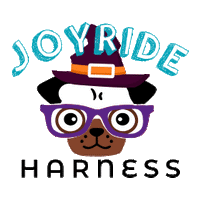3 Life-Changing Hacks for Putting on a Dog Harness

If you're a dog owner, you know that putting on a harness can sometimes feel like a wrestling match. Your furry friend might squirm, wiggle, or even try to escape, making it a challenging task.
However, with the right techniques and a little patience, you can make this daily routine much smoother for both you and your pup. In this guide, we'll explore three life-changing hacks for putting on a dog harness, complete with actionable tips to make the process stress-free.
1. Start With The Right Harness
 Before you even attempt to put on a harness, it's crucial to choose the right one for your dog's size, breed, and specific needs. An ill-fitting harness can lead to discomfort and hinder your ability to put it on easily. Here’s how to select the perfect harness:
Before you even attempt to put on a harness, it's crucial to choose the right one for your dog's size, breed, and specific needs. An ill-fitting harness can lead to discomfort and hinder your ability to put it on easily. Here’s how to select the perfect harness:
Measure Your Dog
Accurate measurements are essential for finding the right fit. Use a soft measuring tape to measure the circumference of your dog's chest and neck. You can usually find sizing charts provided by harness manufacturers to help you choose the correct size based on these measurements.
Consider Your Dog's Breed and Activity Level
Different breeds have different body shapes and energy levels. For instance, a small, delicate harness may be suitable for a Chihuahua but not for a Labrador. While some harnesses are great for dogs of any shape, like the Joyride Harness, many are not and won’t safely hold your dog as you walk. Additionally, if your dog is active, consider a harness with padding and secure fastenings for added comfort and safety during walks and other activities.
Check for Adjustability
Look for a harness with adjustable straps to ensure a snug fit. This allows you to customize the harness to your dog's body shape and prevent it from slipping off or causing discomfort. Adjustable harnesses are especially important for puppies as they grow.
2. Practice Positive Reinforcement

positive experiences. Here's how to do it:
Treats and Praise
Before even attempting to put on the harness, let your dog interact with it. Offer your dog some tasty treatsand praise to create a positive association as they’re investigating it. This step helps your dog view the harness as something rewarding. If your dog is more toy-motivated than treat- or praise-motivated, you can offer them a new toy or some time with an old favorite when they interact with the harness.
Gradual Introduction
Introduce the harness slowly. Let your dog sniff it and explore it at their own pace. This reduces anxiety and makes the harness seem less intimidating.
Build Positive Associations
Put the harness on your dog before engaging in enjoyable activities like playtime or a walk. Over time, your dog will start to associate the harness with fun, making it easier to put on.
Harness "Dress Rehearsals"
Practice putting the harness on and taking it off without any other intentions. This will help your dog get used to the process, so they don't associate it solely with leaving the house. You can offer them treats or even feed them in their harness to add extra positive associations to it. Your dog will be happy in their harness in no time at all.
3. Make It Easy On Yourself… and Your Dog!

Some dog harnesses can only be described as contraptions. They’re a tangle of buckles and straps, and they aren’t even comfortable for your dog. You could get a harness where you have to train your dog through a whole sequence of “Step” and “Sit” and “Stay,” or you could skip this whole process entirely and get a harness that goes on easily to begin with.
Of course, that means finding a harness that’s designed for easy access. You want something that’s breathable, yet padded enough that all dogs are comfortable in it. You want something that can adapt to different sizes of dog, conforming to your pup’s unique size and shape. And you want something safe, with secure straps and a way to prevent pulling.
In short, you want the Joyride Harness. Our harness goes on and off in two seconds flat. There’s one secure buckle– no need to try to match front and back straps. The neck strap is comfortably low, and the side and center leash attachment points mean that your pup can’t pull and put pressure on their neck. The harness won’t hurt your dog’s sensitive armpits (another reason many dogs hate getting into their harnesses).
Come see why the Joyride has veterinarians and pet parents alike howling with joy, and see how much more fun walks can be when your harness goes on easily.





















